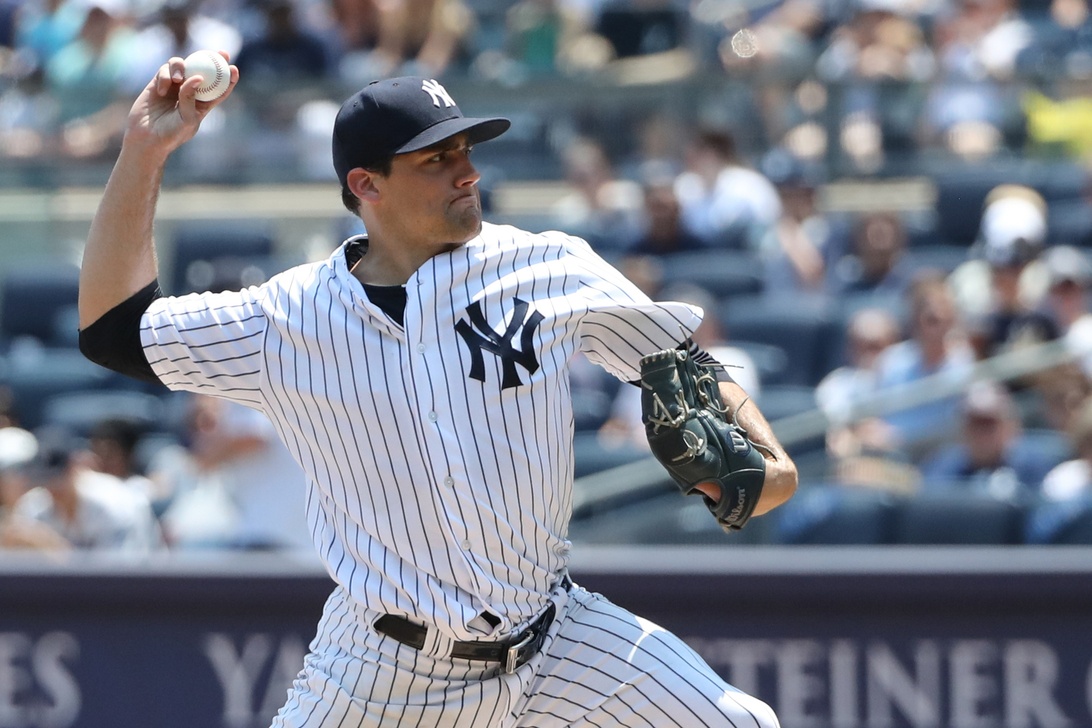Nothing offends the sensibilities of sports fans more than seeing what they perceive as great potential “going to waste.”
If people believe you are especially talented, you’d better produce or you will surely incur the wrath of the masses. If the general consensus is that you posses unremarkable tools then you have carte blanche to suck.
Nathan Eovaldi has never had that luxury. When you can sit at 97-98 as a starter the expectations are going to be there.
At the age of 26 he hasn’t met them yet. Eovaldi’s had flashes of brilliance and overall he’s provided value, but he’s never lived up to the promise of his big arm. Recently things have gotten worse for the right-hander as he’s found himself in the bullpen where once-promising starters go to die and/or carve out lengthy and lucrative careers.
The idea of Eovaldi as a reliever is certainly an unpalatable one to New York Yankees fans. It’s a sign that he’s failed and perhaps has wasted his talent in the eyes of some. However, instead of reacting to this with indignation, it’s worth taking a moment to dream on what Eovaldi could be as a reliever. It’s hard to do considering the Yankees need long-term value more than short term upgrades. The fact the team needs another elite bullpen arms like an octopus needs a hedge trimmer doesn’t help matters.
To figure out what Eovaldi could be in the bullpen you need to consider what the transition to relief does to a pitcher. There are three primary effects of becoming a reliever:
1) You throw harder
For Eovaldi this is hardly possible. As a starter in 2016 he’s averaged 97.98 mph on his fastball. That’s already an ungodly number for a reliever, just below the Aroldis Chapman tier.
However, in his two relief appearances this year Eovaldi has outdone himself from a velocity standpoint averaging 99.13 mph on the heater. While he himself is a perfect example of why velocity isn’t everything, that’s an impressive number. It’s also slightly skewed by the length of his relief appearances as they’ve covered 6 1/3 innings. In one-inning stints a three-digit average isn’t out of the question.
Eovaldi might not get as big a boost as some pitchers would moving to relief, but he would put himself in rare company velocity-wise and give himself even more room for error.
2) You can simplify your repertoire
If you aren’t turning over a lineup multiple times there’s less need for diversifying your pitch usage. As a result, you can dump your weaker offerings and focus on what works.
For Eovaldi that’s the fastball and the splitter. Though he has left the latter up and being hurt at times, it’s still a strong pitch. If he went to a fastball-splitter combo it would give him the Koji Uehara repertoire, except he throws both pitches with 10 mph more juice. While he’d have a way to go to replicate the feats of the ancient Japanese K/BB wizard, he’d have a chance to toy with hitters the same way as the split improved.
Going down that road would mean dropping his slider and curveball. That sounds drastic, but neither has been an effective pitch in recent years. According to FanGraphs pitch values since the beginning of 2015 they have been worth a combined -9.7 runs. Over the same time period batters have hit .296 and slugged .455 against the slider, and he’s gotten as many strikeouts with his curveball (4) and he’s allowed home runs against it (4).
Eovaldi is better off as a two-pitch pitcher, and he could be that guy in relief.
3. You are sheltered from unfavorable matchups
Moving away from starting especially benefits pitchers who have nasty platoon splits because they can be deployed when they have the best chance to succeed and managers can’t stack lineups against them.
Eovaldi’s splits aren’t egregious, but he’d definitely benefit from facing more right-handed hitters. In his career their line against him is .249/307/.378 compared to .296/.359/.432 for left-handers.
In all three cases it’s easy to see how relief could suit the former Los Angeles Dodgers draft pick just fine.
This is not a hot take, as it were. Pitching out the bullpen is easier than being a starter, it’s stands to reason Eovaldi would be better at it. However, his plus-plus velocity and the potential to narrow his focus down to a fastball-splitter repertoire suggest that he could be special in relief.
Eovaldi is not a spring chicken, as the kids like to say. He’s 26 and he’s starter for a some time with mixed results. More recently his production has been on the far negative end of “mixed.” It’s possible he’s just not going to be a great starter. It’s also possible he’s an absolutely dominant reliever.
That’s not what the Yankees need, nor is it what they want. It might be what they’ve got.
Photo: Anthony Grupposo/USA Today Sports
